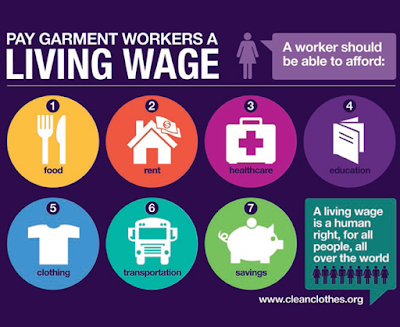From sustainyourstyle.com:
"The fashion industry is the second largest polluter in the world."
"The fashion industry has a disastrous impact on the environment. In fact, it is the second largest polluter in the world, just after the oil industry. And the environmental damage is increasing as the industry grows.
However, there are solutions and alternatives to mitigate these problems. The first step lies in building awareness and willingness to change."
"In most of the countries in which garments are produced, untreated toxic wastewaters from textiles factories are dumped directly into the rivers.
Wastewater contains toxic substances such as lead, mercury, and arsenic, among others. These are extremely harmful for the aquatic life and the health of the millions people living by those rivers banks. The contamination also reaches the sea and eventually spreads around the globe.
Another major source of water contamination is the use of fertilizers for cotton production, which heavily pollutes runoff waters and evaporation waters."
"The fashion industry is a major water consumer. Huge quantity of fresh water are used for the dyeing and finishing process for all of our clothes. As reference, it can take up to 200 tons of fresh water per ton of dyed fabric. Also, cotton needs A LOT of water to grow (and heat), but is usually cultivated in warm and dry areas. Up to 20,000 liters of water are needed to produce just 1kg of cotton"
According to Water Aid, "785 million people don’t have clean water close to home."
When put into perspective, most people would agree this is immoral. However, fashion companies don't want us to know these facts as it would harm their profits.
"The world now consumes about 80 billion new pieces of clothing every year. This is 400% more than the amount we consumed just two decades ago. As new clothing comes into our lives, we also discard it at a shocking pace. The average American now generates 82 pounds of textile waste each year."
"globally, an estimated 92 million tonnes of textiles waste is created each year and the equivalent to a rubbish truck full of clothes ends up on landfill sites every second."
The production of clothing doesn't just harm the planet - a huge number of companies exploit the workers who produce garments by underpaying them, using child labour and making them work in dangerous conditions.
Also from sustainyourstyle.com
"Most of our clothes are made in places where workers’ rights are nonexistent"
"We have know this for decades: most of our clothes are made in countries in which workers’ rights are limited or nonexistent. In fact, production sites are regularly moving location, on the lookout for ever cheaper labour costs.
We often hear company owners saying that "for these workers, it is better than nothing”, “at least we give them a job”, and to a certain extent, they are right. But it is also right to say that they are exploiting the misery and taking advantage of poor populations who have no choice but to work for any salary, in any working conditions. Even the European Parliament is using the term “slave labour” to describe the current working conditions of garment workers in Asia."
"in most of the manufacturing countries (China, Bangladesh, India...), the minimum wage represents between half to a fifth of the living wage. A living wage represents the bare minimum that a family requires to fulfil its basic needs (food, rent, healthcare, education..). So in summary, these brands are bragging about paying their employees 5 times less than what a person actually needs to live with dignity…"
"Garment workers are often forced to work 14 to 16 hours a day, 7 days a week. During peak season, they may work until 2 or 3 am to meet the fashion brand's deadline. Their basic wages are so low that they cannot refuse overtime - aside from the fact that many would be fired if they refused to work overtime. In some cases, overtime is not even paid at all. "
"The collapse of the Rana Plaza in 2013, killing 1134 garment workers in Dhaka, Bangladesh, has revealed the unacceptable working conditions of the whole fashion industry to the world.
Employees usually work with no ventilation, breathing in toxic substances, inhaling fiber dust or blasted sand in unsafe buildings. Accidents, fires, injuries, and disease are very frequent occurrences on textile production sites.
On top of that, clothing workers regularly face verbal and physical abuse. In some cases, when they fail to meet their (unreachable) daily target, they are insulted, denied breaks, or not allowed to drink water."
"168 million children in the world are forced to work.
Because the fashion industry requires low-skilled labour, child labour is particularly common in this industry.
In South India, for example, 250,000 girls work under the Sumangali scheme, a practice which involves sending young girls from poor families to work in a textile factory for three or five years in exchange for a basic wage and an lump sum payment at the end to pay for their dowry. Girls are overworked and live in appalling conditions that can be classified as modern slavery."
So how can this information be communicated through graphic design?
One way is through infographics. "Infographics are graphic visual representations of information, data, or knowledge intended to present information quickly and clearly. They can improve cognition by utilising graphics to enhance the human visual system's ability to see patterns and trends."
Here are some examples of 'infographics' taken from the websites I found the above research on. I personally like infographics a lot as I think they make information a lot more comprehensible, especially for people who are visual learners.
Infographics are a popular way to spread information online as they are concise and eye-catching.








No comments:
Post a Comment